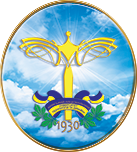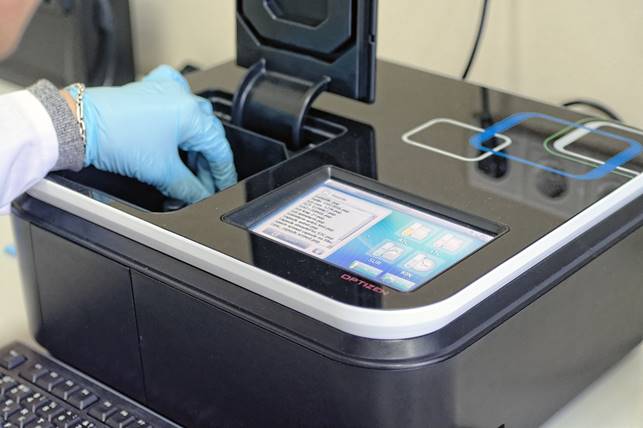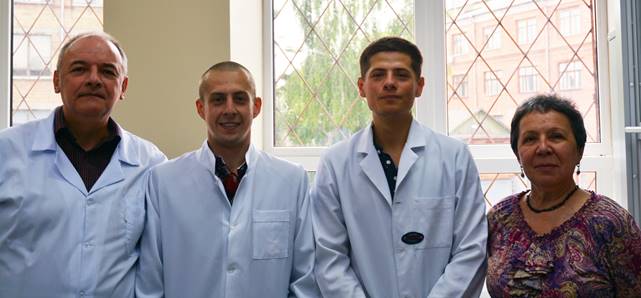The scientific direction "Biology and Health Care" at the Kyiv National University of Technology and Design was started together with the formation of the Department of Industrial Pharmacy only 17 years ago. Today, this area is one of the fastest growing among the research areas of the university, both in terms of staffing and the pace of expansion of research.
The formation of a scientific school in the field of "Biology and Health" began with the approval of the Academic Council of the University in 2016 a new scientific direction of KNUTD "Fundamental technologies of active longevity" and the opening of educational and scientific laboratory of molecular pharmacology, chemogenomics and biogerontology (MPCB Laboratory) (scientific director Doctor of technical sciences, Associate Professor, Professor of Industrial Pharmacy Department Volodymyr Bessarabov).
The high level of research work performed in the laboratory was confirmed by the results of successful state certification. Kyiv National University of Technology and Design is certified in the scientific field "Biology and Health", category B, according to the Order of the Ministry of Education and Science of Ukraine № 372 of March 25, 2021 "On the results of state certification of higher education institutions and science of Ukraine, in terms of their scientific (scientific and technical) activities. "
The staff of the MPCB Laboratory research team is dynamically growing in terms of quantity and quality and is as follows today:
Doctor of Technical Sciences, Associate Professor, Scientific Director of the Laboratory Bessarabov Volodymyr;
PhD in Chemistry, Associate professor, senior researcher Kuzmina Galyna (responsible researcher of GDR);
PhD in Pharmacy, Associate Professor, Senior Researcher Saliy Olena;
PhD in biology, senior researcher Kharitonenko Anna;
Head of the educational laboratory Lisovy Vadym;
postgraduate student Zderko Nazar;
postgraduate student Obolonyk Anton;
postgraduate student Pashchenko Irina;
postgraduate student Oliynyk Dmytro;
postgraduate student Boguslavsky Eugene;
postgraduate student Kovalevska Olga;
postgraduate student Povshedna Iryna;
postgraduate student Kostyuk Victor;
postgraduate student Sachenko Yevheniya;
postgraduate student Smishko Roman;
senior laboratory assistant Ladan Alexander;
senior laboratory assistant Kharchenko Artem;
senior laboratory assistant Savchenko Karina;
senior laboratory assistant Lyzhnyuk Victoria.
 |
Educational and scientific laboratory of Molecular pharmacology, Chemogenomics and Biogerontology |
|
scientific director,
Doctor of technical Sciences, Associate Professor
Volodymyr Bessarabov
Department of Industrial Pharmacy
Address: Kyiv, street Nemirovicha-Danchenko, 2,
building 1, floor 2, laboratory 1-219.
e-mail:
|
DIRECTION OF SCIENTIFIC ACTIVITY
Fundamental technologies of active longevity.
MAIN TOPICS OF PROSPECTIVE SCIENTIFIC RESEARCH:
- Development of composite materials based on pharmaceutically acceptable polymers to increase the bioavailability of active pharmaceutical ingredients.
- Research of biological activity of extracts from biotechnological plant staff for the purpose of development of pharmaceutical compositions of anti-inflammatory and antiviral action.
- Investigation in silico and in vitro of pleiotropic effects of biologically active substances as antioxidants, inhibitors of human cholinesterases and 15-lipoxygenase, which are aimed at finding new active pharmaceutical ingredients of drugs for the treatment of neurodegenerative diseases.
- Development of drugs with controlled release of active pharmaceutical ingredients.
- Development of perfumes and cosmetics with medicinal properties.
- Development and research of nanostructured ecologically safe systems of decontamination of organophosphorus toxic substances (pesticides and active pharmaceutical ingredients) and technologies of equipment cleaning of chemical-pharmaceutical enterprises.
LABORATORY EQUIPMENT
- Scanning UV-Vis spectrophotometer Optizen POP (Mecasys, South Korea).
- Scanning UV-Vis spectrophotometer Specord 200 (Analytik Jena, Germany).
- FTIR spectrophotometer Perkin Elmer Spectrum 1000 (Perkin Elmer, USA).
- Semi-automatic biochemical analyzer Biochem SA (High Technology, USA).
- Agilent 1100 Series HPLC chromatograph (Agilent, UK).
- Amperometric Detector (Biotech Instruments, UK).
- Laboratory installation of water treatment RO-4 (Werner, Germany).
- Installation for obtaining high-purity water Sartorius Stedim biotech Arium H2O pro DI-T (Sartorius, UK)
- AccuLab ALC 110.4 analytical balance (Sartorius, UK).
- pH meter pH-150 MI (RF).
- Expandable ionAnalyzer EA 9256 (Orion Research, UK).
- Installation for determining the melting point of Buchi Melting Point B-545 (Buchi, Switzerland).
- Programmable Rheometer Brookfield Model DV-III (Brookfield, UK).
- Thermo Temperature Controlled Bath PSl Rheotek TCB-8 (Brookfield, UK).
- Buchi Extraction Unit B-815 (Buchi, Switzerland).
- Thermostat Brookfield TC-200, TC-350 (Brookfield, UK).
- Installation for studying the dissolution kinetics of solid dosage forms Vankel VK7000, VR750D, VK8000 (Vankel, USA).
- Installation for studying the kinetics of decomposition of solid dosage forms (PharmaTest, Germany).
- Laboratory microcentrifuge CM-8 (Micromed, China).
- Laboratory centrifuge CM-3 (Micromed, PRC).
- Robotic analyzer of antioxidants and free radicals PHOTOCHEM (Analytik Jena, Germany).
- Shaker SF1 (Stuart, UK).
- Tablet hardness tester VK 200 (Varian, Inc., USA).
- Conductometer portable KP-150 MI (RF).
- Atomic absorption spectrometer Unicam 929A Spectrometer (Unicam, USA).
- Thermostat for ditch DB-10C (Biosan, Latvia).
- TS-100C Thermo-shaker with cooling for Eppendorf test tubes with SC-24C unit (Biosan, Latvia).
- VanKel VK200 tablet hardness tester (Vankel, USA).
- Sanyo Gallenkamp melting point device (Sanyo, Japan).
- Scales moisture meter RADWAG MA 50.R (RADWAG, Republic of Poland).
- Photocolorimeter KFK-2 (RF).
- Scanning UV-Vis spectrophotometer Lambda 25 (Perkin Elmer, USA).
- Laboratory pH / mV / EC / TDS / Temp AD8000 multimeter (Adwa, Hungary).
- Tablet press EP-1 Vers2 (Erweka, Germany).
- DT 800 LH dissolution tester (Erweka, Germany).
- FRL 804 sampling device (Erweka, Germany).
PAID SERVICES
- Development and validation of bioanalytical methods for determining the concentration of active pharmaceutical ingredients (API) and their metabolites in various biological fluids and tissues (blood plasma, urine, etc.);
- Routine analysis of samples according to validated methods;
- Determination of pharmacokinetic parameters;
- Preparation of research reports in accordance with national and international requirements.
A set of in vitro studies in the ADMET category (absorption, partition, metabolism, excretion and toxicity) used in the modern global pharmaceutical industry to develop and improve new drug candidates at an early preclinical stage.
A wide range of in silico research in the field of chemoinformatics, hemogenomics and bioinformatics:
- Selection of various compounds according to structural or pharmacophore criteria from the composition of API registered in the world pharmacopoeias in accordance with the requirements of the task (customer).
- Selection of candidate molecules through virtual screening based on molecular docking and pharmacophore modeling.
- Evaluation of physicochemical properties based on computer calculations or experiment.
- Molecular dynamics calculations and conformation analysis of biomolecules.
- Identification of binding centers and construction of a pharmacophore model.
- Estimated assessment of specific pharmacological activity.
- Potential pharmacological profile using ADME-Tox tests.
- Definition a structure-activity link (QSAR) and a structure-property link (QSPR).
- Prediction in silico of API metabolism sites for cytochromes P450 (5 basic of human).
- Prediction in silico of API-induced changes in the gene expression profile (separately for protein and mRNA).
- Prediction in silico of API cytotoxicity for tumor and non-tumor cell lines.
- Prediction of in silico endotoxicity (acute toxicity) of LD50 based on QSAR analysis of toxicological effects of chemicals on model organisms (rats) at four types of administration (oral, intravenous, intraperitoneal, subcutaneous).
- Prediction in silico of exotoxicity (environmental toxicity) based on QSAR calculation for the following indicators: 96-hour golian (lat. Phoxinus) in 50% of lethal concentration, 48-hour daphnia magna (lat. Daphniamagna) in 50% of lethal concentration, Tetrahymena pyriformis in 50% of the concentration of growth inhibition and bioaccumulation factor.
POSSIBILITIES OF PRE-CLINICAL API RESEARCH
- Physico-chemical properties.
- Determination of melting point (installation for determining the melting point of Buchi Melting Point B-545 (Buchi, Switzerland).
- Determination of dissolution in water, polar and non-polar solvents (kinetic and thermodynamic measurements with UV-Vis and HPLC quantitative detection of solutes).
- Analysis of chemical stability in aqueous buffer solutions at different pH values (kinetic and thermodynamic measurements with UV-Vis and HPLC quantitative detection of solutes).
- LogD / LogP lipophilicity study.
- Investigation of the dynamic viscosity and other rheological characteristics of liquid and pasty APIs (Programmable Rheometer Brookfield Model DV-III (Brookfield, UK)).
Metabolism of API in vitro
- Kinetic studies of the stability of API in human serum (with UV-Vis and HPLC quantitative detection of substances).
Specific pharmacological activity:
- Kinetic studies of inhibition of human serum butyrylcholinesterase with determination of Ki and IC50 (with UV-Vis quantitative detection).
- Kinetic studies of acetylcholinesterase inhibition with determination of Ki and IC50 (with UV-Vis quantitative detection).
- Kinetic studies of 15-lipoxygenase inhibition with determination of Ki and IC50 (with UV-Vis quantitative detection).
- Kinetic studies of activation / inhibition of superoxide dismutase (SOD) with determination of Ki and IC50 (with UV-Vis quantitative detection).
- Study of inhibition of peroxidation of human plasma proteins (with UV-Vis quantitative detection).
- Study of inhibition of lipid peroxidation of human blood plasma (with UV-Vis quantitative detection).
- Investigation of inhibition of free radical formation in the chemical RedOx system based on auto-oxidation of adrenaline (with UV-Vis quantitative detection).
- In vitro study of the potential cardiotonic activity of API (with UV-Vis quantitative detection).
- Investigation of the photoprotective properties of API in different ranges of the UV spectrum (with UV-Vis quantitative detection).
POSSIBILITIES OF LABORATORY TECHNOLOGICAL AND BIOPHARMACEUTICAL RESEARCH OF MEDICINES
- Pharmacopoeial dissolution test for solid dosage forms (installation for studying the dissolution kinetics of Vankel VK7000, VR750D, VK8000 (Vankel, USA), followed by UV-Vis or HPLC quantitative detection).
- In vitro comparative studies to confirm the equivalence of drugs in solid dosage form of systemic action (installation to study the dissolution kinetics of Vankel VK7000, VR750D, VK8000 (Vankel, USA), followed by UV-Vis or HPLC quantitative detection).
- Pharmacopoeial disintegrationTest for solid dosage forms (device for studying the degradation kinetics (PharmaTest, Germany), followed by UV-Vis or HPLC quantitative detection).
- Determination of weight, hardness, diameter and thickness of tablets.
- Study of dynamic viscosity and other rheological characteristics of ointments, pastes and gels (Programmable Rheometer Brookfield Model DV-III (Brookfield, UK)).
- Study of chemical compatibility and stability of API and excipients.
POSSIBILITIES OF TECHNOLOGICAL RESEARCH OF MEDICINE
- Development of technology (chemical production schemes, technological schemes and technological regulations of production) of APIs and medicines in accordance with GMP requirements.
- Development of regulatory documentation of various levels for the production of APIs and medicines.
- Identification of risks to quality in the technological process of production of APIs and drugs.
LABORATORY PHOTOS
























